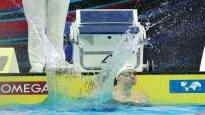In 2008–2009, horrific ME workings were seen in swimming. Several records made in miracle costumes have already been broken, but some wild world record still holds its mark.
It was considered eternal. Uintilegenda Michael Phelps set a world record of 4.03.84 in the 400m medley at the 2008 Beijing Summer Olympics, for which no significant threat was found at the time.
The men’s 400m medley final at the World Championships in Budapest’s long-distance race last Saturday knocked out the jaws of many people following the swim. A Frenchman in his twenties Léon Marchand cannoned his lavish record time and the second toughest time of all time in the trip 4.04.28. Before him, closer to Phelps’ time had reached the United States Ryan Lochte in 2012 during the period 4.05.18.
We will return to Marchand later, but take a history trip to 2008-2009, when, among other things, Phelps, who won the historic eight Olympic gold medals, was in the toughest condition of his career. Those years are remembered for the ME crushers. As many as 25 world records were set at the 2008 Beijing Olympics.
A year later, at the World Championships in Rome, the pace was even fiercer. As many as 43 world records were set, 33 of which came from the current Olympic sports.
At that time, ME talks were largely due to so-called rubber suits, which were banned after 2009. Jani Sievinen once held the ME time of 200 meters of mixing from the 1990s to the early 2000s. He admits that more than 10 years ago, the ME crushers became a blunder.
– I was in Rome on the spot. World records are suffering from huge inflation, Sievinen recalls.
The story continues after the infographics.
The ME pace stopped for a moment
When rubber suits were banned, the ME scores ran out like a wall. The next couple of years were quiet. In 2011, Lochte broke his compatriot and tough rival Phelps in the 200-meter medley with a ME result of 1.54.00.
When Sievinen and Antti Kasvio were at their peak in the 1990s, there were little speedos. The development was drastic.
Since the rubber suit era, 49 ME times have been seen in those personal Olympics that have been involved since 2009. A total of nine records have been recorded in six messaging trips.
Women’s 1,500m US Queen of Swimming Katie Ledecky has clocked six ME results. That trip was included at the Olympic level for the first time last year.
– I’m surprised how quickly the swimmers closed the gap. Even if you look at the results of the 2011 World Championships, the level of results was far from what it was in 2009, Sport’s swimming expert Ville Kallinen says.
A wild ME development on Mattsson’s journey
Compared to rubber suit times, the world record has been set for men’s 50-800-meter freestyle, men’s 400-meter medley, women’s 200-meter butterfly and women’s 200-meter freestyle. Although Ausralian Ariarne Titmus was only 11 hundredths left at the Tokyo Olympics Frederica Pellegrinin 13 years old 200m freestyle ME.
Why, for example, the Brazilian César Cielo Filhon The approximately 13-year-old ME times of the 50-meter freestyle (20.91) and the 100-meter freestyle (46.91) still hold their ground?
– I have to say that Cielo, for example, was an exceptional swimmer anyway. He won world championships even after wearing rubber suits. Caeleb Dressel however, there is a swimmer who breaks Cielo ‘s records if everything hits right, Kallinen sees.
Sievinen says that rubber dressers especially prefer big sizes Paul Bierdermannia. The German swimmer owns the ME times of the 200 and 400 meter freestyle.
– Biedermann was such a swimmer that if he had been made to swim at low speeds, he would hardly have reached the finals. He benefited exceptionally from the buoyancy of the rubber suit.
On the men’s side, wild rides have been seen, especially during breastfeeding trips. Five times in the 100m breaststroke ME time improved in the UK Adam Peaty (ME 56.88) is as low as 34 times Australian Brendon Richardin in 2009 swam ME time 58.58.
Matti Mattssonin on the main distance in the 200-meter breaststroke, the ME time behind Rome’s ME swimming has been petrified for almost a second and a half.
– Breaststroke has become really much straightforward and streamlined. When you look at the kicks of previous swimmers, they have been really wide and long kicks. For example, Peaty’s kick is really narrow and fast again, Kallinen says.
Will the last rubber costumes finally go down in history?
So far, two ME results have been seen at the World Cup in Budapest. Italian Thomas Ceccon was responsible for the new ME time in the men’s 100m backstroke and Hungary Kristof Milak in the men’s 200m butterfly.
However, the most memorable names for the Games are Marchand, Romania, France David Popovici as well as Canada Summer McIntosh. Marchand has won both men’s medley trips so far and both won one silver.
Popovici, a 17-year-old who swam the ME times of the youth, cannoned to the victories of the 100 and 200-meter freestyle trips. His 200-meter youth ME bet was 1.21 seconds behind Biedermann’s world record of 1.42.00. Only 15-year-old McIntosh won the women’s 200m butterfly world championship and was second in the 400m freestyle.
Both Kallinen and Sievinen have been impressed by the trio’s presuppositions. Marchand and Popovici compete on those trips where ME times have been tight.
– These three are the super promises. It is very likely that Popovici will break the rubber record world records by both a hundred and a second. They are very likely to be Olympic winners in two years in Paris, Sievinen believes.
